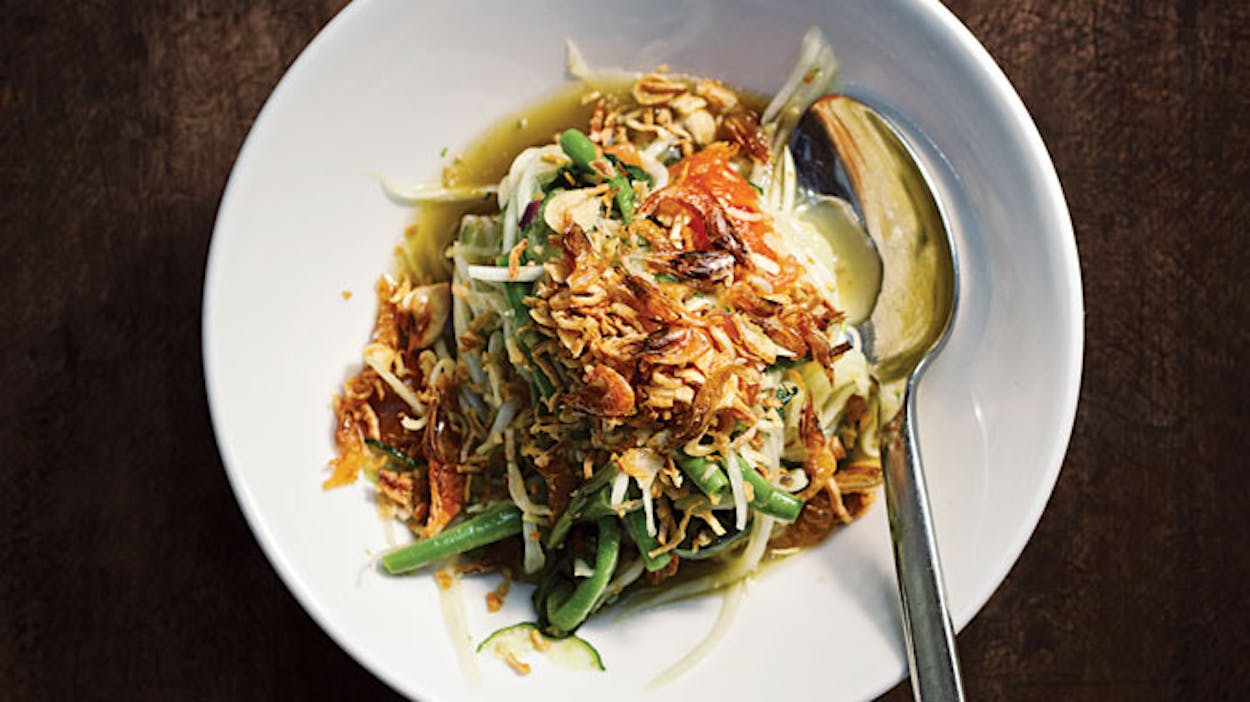At Sway, any perch at the long kitchen counter is the catbird seat. I sit here whenever I can, even though joining friends at one of the restaurant’s massive square mahogany tables has definite appeal if I’m in a party mood. But it’s a live cooking show at the counter, as one person pounds lethal-looking Thai chiles in a huge mortar, another harvests fresh basil from a wooden box, and yet another deep-fries a whole red snapper. The people-watching is great too. Out of the corner of my eye, I see a young woman with her black hair in pigtails hurrying across the kitchen. That would be executive pastry chef Laura Sawicki, recently a semifinalist in the James Beard Foundation’s culinary awards competition. A few yards away, with a bandana tied around his head, is executive chef Rene Ortiz, also a Beard semifinalist. (On the rare occasion that I miss them, I assume they are at Sway’s sibling, the modern Mexican restaurant La Condesa.) Located on South First, the city’s hot restaurant row, this contemporary Thai destination is one of a group of lively Asian-oriented eating places—Ramen Tatsu-Ya, Elizabeth Street Café, Komé—that have been popping up around town recently. All have singular, even unlikely histories, but it’s probably safe to say that Sway is the only one headed by a self-taught, Texas-born, New York–trained Mexican American chef who fell under the spell of Thai cooking while living in Australia.
Ortiz’s odyssey began in 2003, when at 28 he went to Sydney to rework two restaurants for Coyote Cafe chef-owner Mark Miller. Interested in Thai cooking since the nineties, he landed in the middle of a vibrant, often avant-garde food scene. Some Aussie chefs, notably David Thompson and Martin Boetz, had brazenly taken it upon themselves to revive and modernize Thai techniques and dishes that they feared were on the verge of extinction. It was an unparalleled opportunity, and Ortiz knew it. He met the major players, traveled the region, and spent hours watching and tasting in restaurant kitchens and private homes. In 2005, when he returned to the States, he had filled a dozen notebooks with recipes and drawings. And then he proceeded to wait, working in many cities, until one day the stars aligned and he met two New York investors, Jesse Herman and Delfo Trombetta. By the strangest of coincidences the entrepreneurs had each lived in Thailand, though at different times. Herman had also lived in Sydney. But the three didn’t discover their mutual love of Thai food until well after they had developed La Condesa, their first restaurant. One evening for a friend’s birthday, Ortiz made several Thai dishes. Afterward, Herman asked why he chose them. Ortiz told him about living in Sydney and, Herman says, “a lightbulb kind of went off.” After that, a joint Thai project was inevitable. It took a while for things to fall into place, but eventually they did. “Fifteen years,” says Ortiz, sounding slightly stunned. “That’s how long I’ve wanted to do this.”
If you’re curious to know what Ortiz learned in Australia, go for the prawn miange, a starter that pays homage to a similar dish created by Boetz. Perfect for sharing, it consists of four heart-shaped betel leaves piled high with chilled prawns, grapefruit sections, and toasted cashews. To eat it, you roll the leaf up like a mini-taco and pop it in your mouth. The flavor explosion that rockets around your sinuses owes its pungency to the mix of tamarind, chiles, palm sugar, and Thailand’s indispensable fermented-fish sauce.
I like to follow this with something like the salt-and-pepper cuttlefish, ribbons of the tentacled sea critter covered in salty black beans, lime juice, and roasted red Thai chiles. Chinese in origin—Thailand is quite the melting pot—it also offers a strategic change of pace. Many Thai dishes are defined by the aforementioned umami-rich duo of fish sauces and palm sugar, and if you have two or more in a row, they can grow monotonous. But if you refresh your palate (most of the servers are adept at suggestions), you’ll be up for the chilled green papaya salad, its spicy-sweet flavors set off by the delicate funk of teeny dried shrimp. Then, if you must have serious protein, order the bracing Jungle Curry. Its centerpiece is a gloriously tender hunk of seared braised wagyu tri-tip steak, sided by baby corn and a tangy stem of whole green peppercorns and crowned with a sumptuous dollop of coconut cream.
After three dishes I’m full, but I never, ever miss a chance to have one of Sawicki’s incredible desserts. Their forms may be Western—ice creams, sorbets, brownies, cakes, mousses, even a banana split—but their flavors absolutely nail the Far East. Two bites into her jasmine tea panna cotta with coconut-lychee sorbet, I was imagining a garden of night-blooming flowers. And magic was clearly at work in Soy, in which she transforms an ingredient list from crazyland—sweet soy sauce, kabocha squash, chocolate mousse, soy milk, nashi pears, and brown butter streusel—into one of the most seductive combinations I’ve ever put in my mouth.
Beyond sated, I relinquish the catbird seat and head home. But I can’t help thinking of something Ortiz said earlier when I asked him why he does what he does. “Every day I want to see people go ahhhhhhh!” he said. “That and see them smile. Those are the reasons I’m in this business.” If that’s what the man wants, I think he’s got it. swayaustin.com
- More About:
- Pat’s Pick









